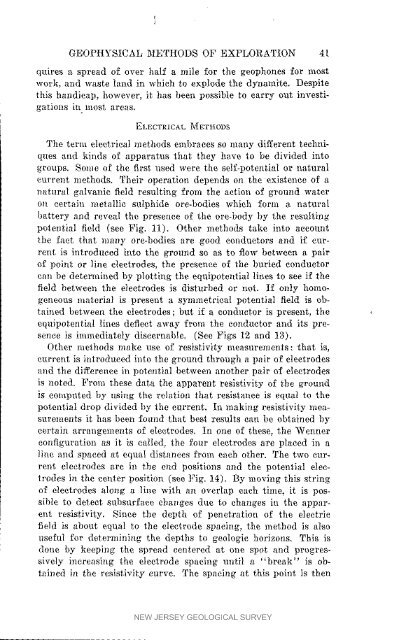Bulletin 54. Geophysical Methods of Exploration and their ...
Bulletin 54. Geophysical Methods of Exploration and their ...
Bulletin 54. Geophysical Methods of Exploration and their ...
You also want an ePaper? Increase the reach of your titles
YUMPU automatically turns print PDFs into web optimized ePapers that Google loves.
GEOPHYSICAL METHODS OF EXPLORATION 41<br />
quires a spread <strong>of</strong> over half a mile for the geophones for most<br />
work, <strong>and</strong> waste l<strong>and</strong> in which to explode the dynamite. Despite<br />
this h<strong>and</strong>icap, however, it has been possible to carry out investigations<br />
in nlost areas.<br />
ELECTRICAL<br />
M_.THODS<br />
The term electrical methods embraces so many different techniques<br />
<strong>and</strong> kinds <strong>of</strong> apparatus that they have to be divided into<br />
groups. Some <strong>of</strong> the first used were the self-potential or natural<br />
current methods. Their operation depends on the existence <strong>of</strong> a<br />
natural galvanic field resulting from the action <strong>of</strong> ground water<br />
ou certain metallic sulphide ore-bodles which form a naturM<br />
battery <strong>and</strong> reveal the presence <strong>of</strong> the ore-body by the resulting<br />
potmJtial field (see Fig. 11). Other methods take into accmmt<br />
the fact that many ore-bodies are good conductors <strong>and</strong> if current<br />
is introduced into the ground so as to flox_ between a pair<br />
<strong>of</strong> point or line electrodes, the presence <strong>of</strong> the buried conductor<br />
can be determined by plotting the eqnipotential lines to see if the<br />
field between the e)ectrodes is disturbed or not. If only homogeneous<br />
material is present a symmetrical potential field is obtained<br />
betweeu the electrodes; but if a conductor is present, the<br />
equipotential lines deflect away from the conductor <strong>and</strong> its presence<br />
is immediately discernable. (See Figs 12 <strong>and</strong> 13).<br />
Other methods make use <strong>of</strong> resistivity measurements: that is,<br />
current is introduced into the ground through a pair <strong>of</strong> electrodes<br />
<strong>and</strong> the difference in potential between another pair <strong>of</strong> electrodes<br />
is noted. From these data the apparent resistivity <strong>of</strong> the ground<br />
is computed by using the relation that resistance is equal to the<br />
potential drop divided by the current. In making resistivity measurements<br />
it has been found that best results can be obtained by<br />
certain arrangements <strong>of</strong> electrodes. In one o£ these, the Wenner<br />
configuration as it is called, the four electrodes are placed in a<br />
line <strong>and</strong> spaced at equal distances from each other. The two current<br />
electrodes are in the end positions <strong>and</strong> the potential electrodes<br />
in the center position (see Fig. 14). By moving this string<br />
<strong>of</strong> electrodes along a line with an overlap each time, it is possible<br />
to detect suhsurface ebaz_gcs due to changes in the apparent<br />
resistivity. Since the depth <strong>of</strong> penetration <strong>of</strong> the electric<br />
field is about equal to the electrode spacing, the method is also<br />
useful for determining the depths to geologic horizons, This is<br />
done by keeping the spread centered at one spot <strong>and</strong> progressively<br />
increasing the electrode spacing m_til a "break" is obtained<br />
ia the resistivity curve. The spacing at this point is then<br />
NEW JERSEY GEOLOGICAL SURVEY

















